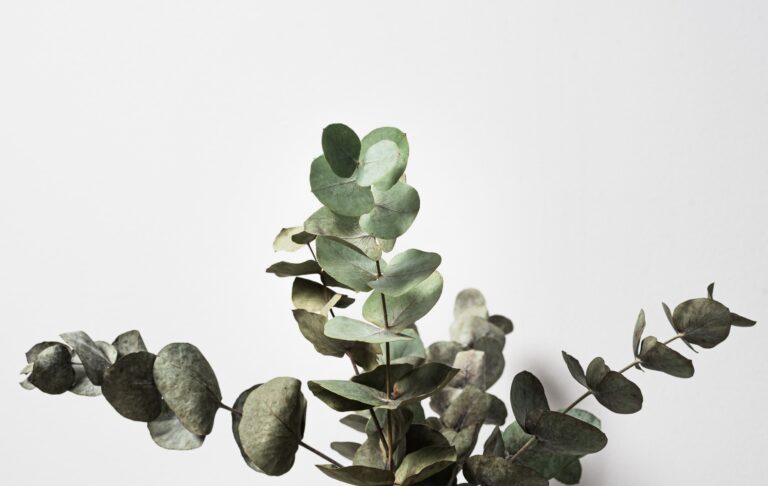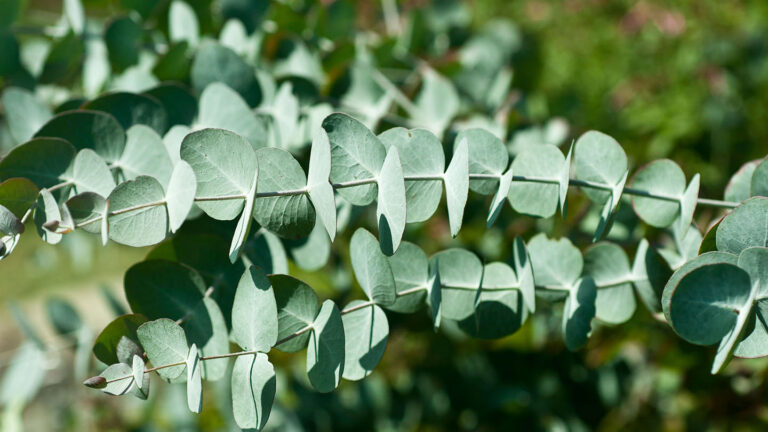Eucalyptus (Eucalyptus cinerea) is an evergreen tree native to Australia, but it can thrive in various regions and climates around the world. This wonderful plant has a distinctive aroma that is used in aromatherapy and medicinal products. Its leaves are commonly used in dried flower arrangements and for their essential oils.
Eucalyptus trees can grow up to 60 feet tall, but there are also dwarf varieties that are suitable for growing in smaller spaces or containers. These trees are relatively low-maintenance and drought-tolerant (unlike the Polka Dot plant), making them an ideal choice for gardeners who are just starting out. However, it’s important to note that some species of eucalyptus can be invasive, so it’s important to do some research before planting.
Most popular eucalyptus varieties:
- Blue Gum (Eucalyptus globulus)
- Lemon-Scented Gum (Corymbia citriodora)
- Dwarf Apple (Angophora hispida)
- Manna Gum (Eucalyptus viminalis)
- Rainbow Gum (Eucalyptus deglupta)
Give it a read

Care
You do not have to do much to care for eucalyptus plants: choose a sunny planting site with well-draining soil and ample space for growth. Avoid planting near trees or shrubs that may block sunlight. The trees do not typically require staking and can be grown in containers or indoors with enough light. It’s best to wait until later in the growing season to harvest mature leaves and branches.
- Soil: good drainage, and slightly acidic to neutral pH is the key to the soil of a eucalyptus tree.
- Water: Eucalyptus plants are somewhat drought-tolerant, but they shouldn’t be left dry for long periods. To avoid dropping leaves, water the plant when the soil feels dry at your fingertip. This may mean watering the plant weekly, especially if it’s grown in a container and there hasn’t been any rainfall.
- Temperature: Eucalyptus thrives in warm temperatures of 65 to 75 degrees Fahrenheit with moderate humidity, and cannot withstand temperatures below 50 degrees Fahrenheit. If you are growing your eucalyptus in a container, it is recommended to bring it indoors during cold weather.
- Light: Eucalyptus plants require a lot of light and should be planted in an area with at least six hours of direct sunlight daily. For indoor plants, a bright window facing south is recommended.
Propagation
Eucalyptus trees are usually grown from purchased seeds but can also be propagated through cuttings. The best time to take cuttings is when the tree is between 2 and 12 months old.
- Prepare a small pot with a composted tree bark-to-perlite ratio of 3:1 and add slow-release fertilizer.
- Cut a stem that’s around 5 inches long with four to eight leaves, and remove the leaves on the lower half of the cutting.
- Dip the cut end in a rooting hormone and plant it in the growing medium, almost up to where the leaves are.
- Keep the container in bright, indirect light in a room that’s around 70 degrees Fahrenheit, and make sure the soil remains lightly moist. Roots should form in about a month, and once the weather is warm enough, the new plant can be brought outdoors for progressively longer stretches before planting in the garden.
Common Pests
- Eucalyptus snout beetle
- Whiteflies
- Gall makers
- Eucalyptus tortoise beetle
- Glassy-winged sharpshooter
- Foliage-feeding caterpillars
- Psyllids
- Roundheaded Borer
Frequently Asked Questions
Eucalyptus is very effective in purifying the air and is also known for its medicinal properties.
Do eucalyptus plants attract bugs?
Eucalyptus is known to attract insects, but fresh eucalyptus bundles are less at risk compared to eucalyptus plants or trees due to their smaller size, lack of soil, and infrequent watering.
What are the dangers of eucalyptus?
When digested, eucalyptus can cause vomiting, nausea, and diarrhea. Not exactly fun times, so stay away from consuming it if you are not a koala.
Can eucalyptus grow in pots?
Yes, you can grow eucalyptus trees in pots, but only for a certain period of time – depending on the size of the pot.

